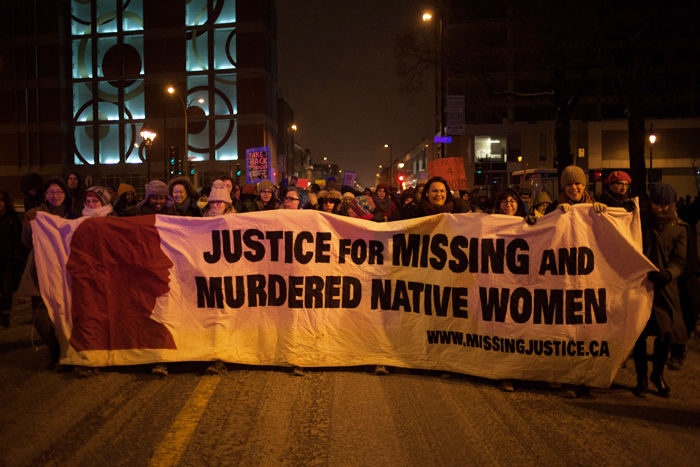The sisters we lost
Hundreds gather on Feb. 14, 2014, in Montreal to support justice for missing and murdered indigenous women. The protest has become an annual tradition across Canada.
February 16, 2016
For many, Valentine’s Day is marked with chocolate, flowers and Netflix binge-watching. For others, this weekend marked the 26th Annual Women’s Memorial March in Canada.
Families, friends and supporters across the country gathered to march for justice, closure and mourning the loss of aboriginal women to murder, rape, violent crimes, abduction or kidnapping.
As an indigenous woman, I am no stranger to abuse, discrimination or racism, and to be honest, it could have been my face on one of those posters or my sisters or my mothers or my aunts or my cousins.
For those of you that don’t know, this march is about mourning the loss of nearly 1,200 indigenous women in Canada, per data collected from the Royal Canadian Mounted Police (RCMP). A newer updated report issued in 2015 estimates there were 174 new cases of missing aboriginal women as of April, which was a staggering 10 percent of the total 1,750 missing women in Canada.
One might argue 10 percent isn’t much, but according to an article published in the Guardian, aboriginal women make up only 4.3 percent of Canada’s total population, yet also make up 16 percent of the homicides.
This would indicate that aboriginal women are being murdered or going missing disproportionately to national averages for other ethnic groups.
Despite the ample media attention in recent years, the RCMP still has yet to fully acknowledge the part they played in the unsolved cases. Many families, via interviews on television, written articles, and other forms, have discussed at length how difficult reporting a missing aboriginal woman is because the police simply don’t believe them, dismiss the situation or insist the woman will come home.
When the woman does not return after weeks, then eventually the RCMP will take a report, but often it is far too late for the women missing and the cases quickly go cold.
The bodies of many indigenous women are found floating in Red River, which flows through Winnipeg, where a large group of women march every year on Valentine’s Day.
Marches for missing or murdered Indigenous women are often full of people, singing, dancing, drumming and even have food, refreshments and potlucks after the march is over.
Many of the organizers and participants are there to honor their missing loved ones in an effort to connect with their lost spirits.
In many native traditions, true mourning cannot take place without a body because the families need to see it in order to confirm who it is and to let them cross over into another world.
The most difficult part for me to handle was how some families never get closure because their loved ones’ bodies were dumped in a river, or too badly damaged to recognize, but confirmed through blood or DNA testing.
In spite of trauma, sadness and despair, women in Canada have set up living memorials to remind everyone that the spirit lives on and although something horrifying occurred, it can still be beautiful.
In one mall in Winnipeg, they release red butterflies; one for every missing murdered indigenous woman. And in another, they take the beaded toe sections of moccasins and put them on the floors or walls. The family usually makes a pair and sends them in with a design that reminds them of the fallen or missing woman in their life.
If you would like to get involved on campus, contact the Native American Women’s Association (NAWA).





















